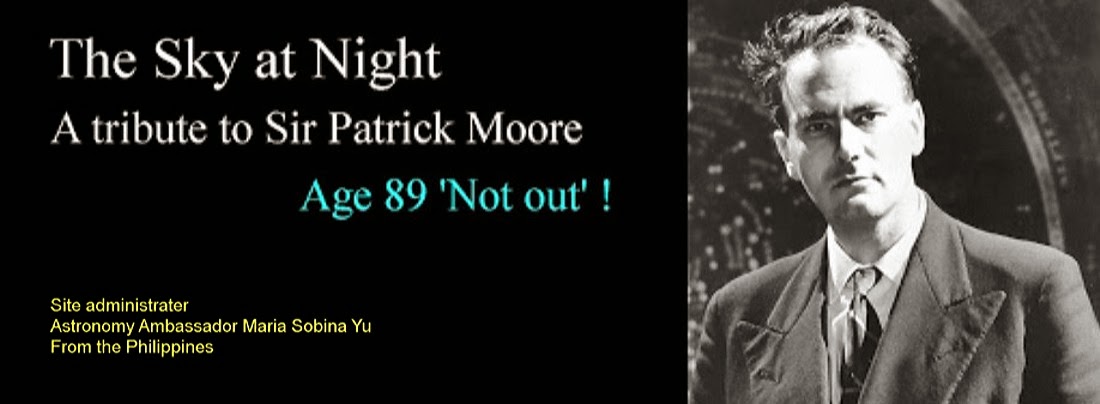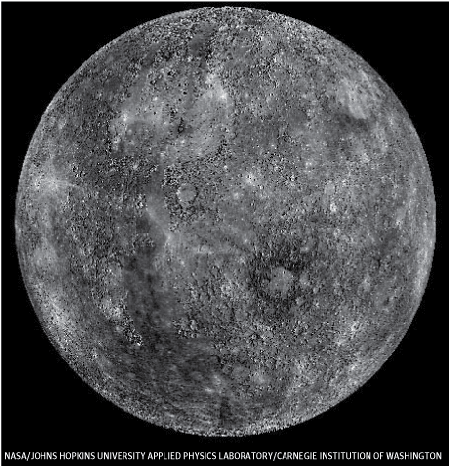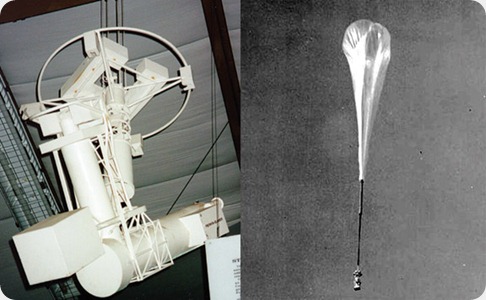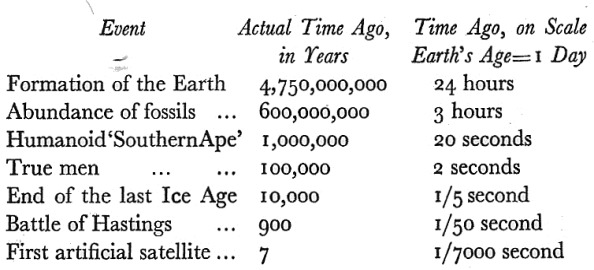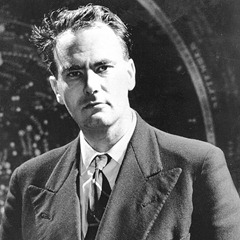It was in the summer of 1965 that the U.S. probe Mariner IV by-passed Mars and sent back photographs showing that the planet's surface is covered with lunar-type craters. When I presented the July programme, with K. H. Fea, the information was still coming through, but there were other topics also; both Mariner IV and the unsuccessful Soviet Mars probe Zond II had sent back information about the conditions prevailing in the space between Mars and the Earth. The term 'space weather' is by no means inappropriate, and we decided to devote the programme to it. I have left the article as it appeared at that time; up to mid-ig6y no further Mars probes were dispatched, though doubtless there will be more in the near future.
Astronomers all over the world are now busy studying the first close-range photographs of Mars, taken with the American space- probe Mariner IV. A full analysis will take some time, but at least it is now clear that the experiment has been a real success. There are grounds for suggesting that it is the greatest triumph yet in the field of space research.
The photographs are much less spectacular than those obtained some months ago when the Ranger craft hit the Moon after sending back highly detailed pictures of the lunar surface. However, Mars is a much more remote target; at the time of Mariner's closest approach to the planet, the distance between Mars and the Earth was in the region of 135,000,000 miles. To keep in touch with the probe across this range was in itself a major feat, and one which proved to be too difficult for the Russians, who have lost all contact with their own Mars rocket, Zond II.
It is not likely that the information obtained from Mariner will solve all the problems of Mars, but it should give us a better idea about conditions on the planet. It must, however, be remembered that in addition to photographing Mars, the probe’ has also told us a great deal about the space region between Mars and the Earth. We know more about the 'space weather' of this part of the Solar System than we could even have guessed a few months ago.
The term 'space weather', originally coined by an American scientist, is not so inappropriate as might be imagined. It should not be taken too literally, since there is no weather, in the accepted sense of the word, above the Earth's atmosphere. All normal clouds, for instance, are included in the bottom seven miles of atmosphere, known as the troposphere; higher up come the more rarefied layers, and the atmospheric mantle has no definite boundary, but it is a good approximation to say that the 'air: ends at about 1,000 miles above sea-level. (Incidentally, the fact that the atmosphere is of limited extent has been realized for a long time, and the Arab astronomers of many centuries ago were well aware of it.)
Beyond the atmosphere lies 'space', but we have come a long way from the time when space was supposed to be completely empty. It is now held that there is no such thing as empty space anywhere in the observable universe, though the material is very rarefied by everyday standards.
First, there are countless meteoritic particles in the Solar System, ranging from large blocks down to tiny objects smaller than specks of dust. Large meteorites, weighing more than a few pounds, are relatively rare, and seem to be close relations of the minor planets or asteroids. Meteors which produce the spectacular shooting-star effects are much smaller, and are inferior in size to grains of sand, so that they are destroyed in the Earth'; upper air; there should be plenty of meteors on view during the first fortnight of August, when the Earth passes through the rich and consistent Perseids. Still smaller is the micro-meteoroid; which has too little mass to produce luminous effects when they enter the Earth's atmosphere.
The meteoroid hazard was one of the early bugbears of spaceflight, and as recently as the early nineteen-fifties it was still claimed, by some authorities, that a probe venturing beyond the shield provided by the Earth's atmosphere would be promptly battered to pieces by a sort of cosmical bombardment. Luckily, this fear has proved to be ill-founded, because the larger bodies are relatively so rare, and the micro-meteoroids have too little penetrating power to be really dangerous. If interplanetary travel becomes common-place during the centuries to come, there may well be occasional disasters; but if meteoroids were the only hazard, a flight from the Earth to the Moon would be much less risky than a weekend drive from London to Margate!
Mariner IV has been recording micro-meteoroid hits throughout its journey, and there seems to be an increase in strike frequency near the Martian orbit, but this was not unexpected. Information has also been provided by the now-lost probe Zond II.
As well as solid particles of this sort, space also contains atoms of gas moving at more than 1,000 kilometres per second. These atoms make up what is known as the solar wind, entirely unknown before space research became a powerful tool in the hands of astronomers. Generally, the solar wind is made up of a steady flow of atomic particles streaming away from the Sun in all directions; the density is so low that a space-probe would find only about ten atoms in every cubic centimetre, but when vast disturbances are taking place on the Sun the density increases - or, to put it more graphically, the solar wind becomes gusty. When the denser parts reach the Earth, they upset the magnetic field, as well as interfering with long-distance radio and cable communications, and producing spectacular displays of polar lights or auroras.
The brilliant surface of the Sun is known as the photosphere, and is at a temperature of about 6,000 degrees Centigrade. It is composed of gas, and upon it may be seen darker patches, known as sunspots. The spots are at a temperature of 4,000 degrees, and are in fact highly luminous, appearing dark only by contrast against the still more dazzling background. They are not permanent; smaller ones persist for only a few hours or days, while it is rare for even a large spot to last for as much as three months.
The Sun is in some respects a variable star, and exhibits a semi-regular cycle of activity. Every eleven years or so, activity is at its peak; spots are common, some of them showing violent, short-lived outbursts known as flares. The last maximum, which of 1957-58, was the most energetic on record, but recently the Sun's activity has been at a low ebb, and there have been long periods when no spots have been seen. It appears that minimum took place during the winter of 1964-65, and by now activity is starting to build up again; the next maximum may be expected about 1969-70.
When the Sun is active, the solar wind is 'gusty'. It originates not at the photosphere, but in the outer parts of the solar atmosphere, known as the corona, in a region about 1,000,000 kilometres above the brilliant surface. Here the gas particles, mainly the nuclei of hydrogen and helium atoms, are in violent motion, and the temperature is about 1,000,000 degrees. Some areas are even hotter (for reasons not yet properly understood), and it ii thought that these areas are the sources of denser streams in the solar wind.
It is worth noting that the scientific definition of 'temperature' is not the same as the everyday understanding of 'heat". Temperature depends upon the speeds at which the various atomic particles are moving about; the greater the speeds, the higher the temperature. In the solar corona, the temperatures are; colossal, but the material is rarefied, so that the actual heat is much less than in the photosphere. There is something to be gained by comparing a Guy Fawkes' hand-sparkler with are ordinary match. Each spark of the firework is white-hot, but: contains so little mass that the sparkler may be safely held in the hand - whereas to put one's finger into a match-flame is apt: be a painful process, though the temperature of the flame _ lower.
Flares, usually - though not invariably - associated with large sunspots, are sources of radiations and particles. The particles cover the 93, 000, 000-mile gap between Sun and Earth in little over one day, and cause major disturbances in the Earth's magnetic field. They also produce auroras, known more commonly as Northern and Southern Lights because they are most common and most brilliant in the polar zones. Spectacular displays in England are infrequent, and are to be expected only when the Sun is near the peak of its cycle; from Scotland, aurora are much more usual, and a winter night in, say, Iceland or Northern Norway would seem strange without them. Occasionally, aurora reach as far south as Italy, and there is a story - almost certainly true - that the Roman Emperor Tiberius once dispatched rescue teams because he mistook a bright aurora for a disastrous fire. The Southern Lights are superb in Antarctica.
Aurora: occur in the upper atmosphere, and are caused when the atoms ejected from the Sun plunge into the higher layers. Analysis of auroral light shows that these atoms - or, more accurately, nuclei of hydrogen atoms - are moving down to the ground at velocities of as much as 5,000 kilometres per second. Aurora are mainly confined to the polar regions simply because the Earth has a magnetic field surrounding it in space, and this field channels the electrically charged atomic particles into the regions near the magnetic poles, so that the original paths of the solar-wind particles are markedly altered. The geographical North and South Poles have nothing directly to do with this; it is the magnetic poles which matter.
Some of the particles are trapped in the Earth's magnetic field, at distances up to about 100,000 kilometres from the ground. These particles are enormously accelerated, by processes not yet well understood, and 'bounce' between the Polar Regions in spiralling and drifting orbits. These regions of trapped particles were completely unknown until 1958, when they were discovered by one of the early American artificial satellites, Explorer I. They have been named the Van Allen Belts, in honour of the U.S. scientist James van Allen, who was mainly responsible for their detection. The lower layers may be the by-products of cosmic rays, but the upper layers are closely connected with the solar wind, varying according to the prevailing 'space weather'.
Some authorities believe that aurora: are caused by clouds in the solar wind which strike the outer part of the Earth's magnetic field and send down a form of shock-wave, so that some of the trapped particles are shaken out of their stable orbits and cascade into the atmosphere near the magnetic poles, rather in the manner of apples shaken out of a tree. On another interpretation, the particles making up the auroras are never truly trapped at all, but are deviated briefly in a complex fashion. The whole matter is now being intensively studied, but at any rate it is clear that aurora are not so simple and straightforward as used to be thought.
Little positive information about space weather could be obtained before the opening of the space age, in 1957, but progress since then has been amazingly rapid. The artificial satellites could provide considerable data, and many vehicles have been launched specially for the purpose. Recently, for instance, there has been another satellite of the so-called 'Imp' series; it has an eccentric orbit, so that it moves partly within the Earth's magnetic field and partly in the relatively remote regions of undisturbed solar wind. Also important have been the Injun satellites constructed at Iowa University, whose main function is to study the trapped and cascading particles in the Van Allen layers.
On a longer-term basis, the discovery of the Van Allen layers seems to have hammered yet another nail into the coffin of the elaborate, manned space-station proposed earlier by Wernher von Braun and other pioneers. There are sound reasons for supposing that a prolonged stay in the main layers would be inadvisable, and the whole idea of a manned base, orbiting the Earth at a height of about 1,000 miles, seems to have fallen into disfavour, though it would be unwise to say that it has been abandoned.
The interplanetary probes have added to our knowledge about space weather in general, and the solar wind in general. Much was gained from Mariner II, which passed within 21,000 miles of the planet Venus in December 1962. The Sun's own magnetic field was studied, and seems to vary according to the state of the solar cycle, so that there are significant differences between the findings of Mariner II and the present Mariner IV. Apparently, when the Sun is active its magnetic field is 'pushed outwards' by the solar wind. During the past few months, when Mariner IV has been on its way, the Sun has been at its least active, so that its magnetic field has reached closer in. Rather fortunately, there was a major flare on the Sun on 5 February 1965, and its effects were recorded by Mariner IV; radiation levels increased by 50 per cent, and two days later the probe detected irregular magnetic fields in space.
One further piece of information is that Mars has no magnetic field comparable in strength with that of the Earth. This means that it can have no Van Allen-type layers either, and the whole situation there is different. It may even be that dangerous radiations can penetrate to the Martian surface, which will make matters much more difficult for future pioneers. However, an immense amount of work remains to be done, and every new development means that the study of space weather becomes more and more complex.
